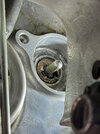This old thread helps me with my new problem. Thanks, Gino, for showing the way!
I pulled my clutch slave cylinder (CSC) last week because of new leakage and dropping fluid level in the master cylinder.
While cleaning out the CSC cavity on the back of the engine, pieces of rubber began shedding from the clutch oil seal which is recessed inside the cavity. Oh boy - what to do? Take a chance that it's just surface rubber but not from the business part of the seal. Down side - put everything back together and end up with hydraulic fluid in the motor oil and vice versa. Not a smart choice of potentially having to go through the agony of removing the CSC
again. And messing up the hydraulics and engine oil (and engine?)
I opted to remove/replace the seal. It was intimidating to consider just how to get the seal out of that tight space. Gino's tips led the way to my success.
Steps to success:
1) I initially tried to use my little hook-tipped tools from Harbor Freight. I stuck the tip in along the clutch rod, then rotated outward to the perimeter of the seal,, but just couldn't get enough "umph" to budge the seal.
2) Next is used a longer rigid wire with a hooked end, but same result.
3) Approaching the point of despair, I re-read Gino's post and saw how he punched some holes through the metal body of the seal, then inserted a screw. With nothing to lose, I followed his lead. I used a thin awl and a light hammer to carefully punch holes at the 5, 6, and 7 o'clock positions of the seal. I then threaded in a medium length drywall screw (having no metal screws available of the needed length) just enough to capture the metal, but not enough to hit the aluminum seat. Finally I engaged the assistance of a little cheater bar and successfully levered the seal out. What a relief!
A new seal has been ordered through my local Honda dealer (Motoworld, El Cajon). Should be in later this week.
Igofar wisely recommended using Permatex Ultra Slick Engine Assembly Lube to lubricate the edge of the seal to avoid damaging the rubber surface when inserting back into its home.









